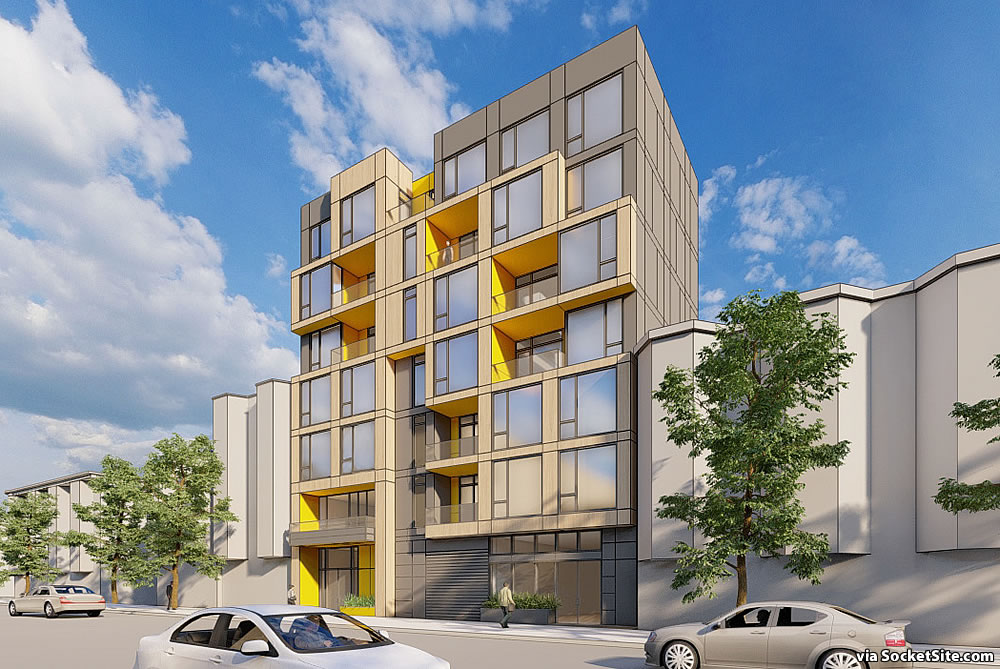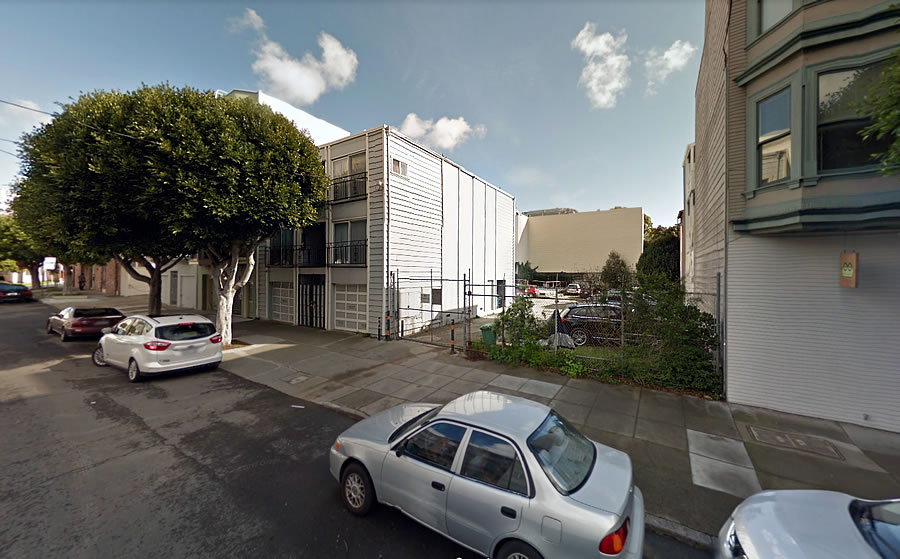As we first reported early last year:
The little four-unit building at 630 Octavia Street and its adjacent parcel, which is currently used as a parking lot, recently traded hands for what would appear to be a total contract price of $4.6 million.
A few years ago, plans to merge the two lots, level the existing building, and develop a new building upon the combined 9,453-square-foot parcel were considered but never pursued. And while the two lots are currently zoned for development up to 40 feet in height, it would appear the recent buyer has even bigger plans.
In fact, preliminary plans to merge the two lots, level the existing building, and construct a new 7-story building upon the combined lot, with 30 units of housing over a ground floor commercial space and a garage for 15 cars, have been drafted. But exactly how the additional height would be achieved has yet to be revealed.
As we subsequently revealed, the project team is planning to employ a State Density Bonus waiver for the additional height and San Francisco’s Planning Department didn’t raise any major red flags with respect to the approach and preliminary plans.
And with the draft plans for the “618 Octavia Street” project having since been redesigned, further densified and newly rendered by Kwan Henmi for March Capital, the proposed 7-story, 74-foot-tall development will now yield 38 condos (a mix of 12 one-bedrooms, 20 twos and 6 threes), with eight (8) of the units to offered at below market rates (BMR), a ground floor retail space and a garage for 25 cars if approved and the ground is broken.





Much better. I really like how the extrusions on the facade match both adjacent building’s rooflines. Feels like a good fit for the quieter block.
Yeah, love the asymmetry. Want to see this size development all over the West side!
Densifying right in time for the Great SF Exodus.
We could see a substantial population decline (which we won’t) and we still wouldn’t have enough housing, even including every project in the pipeline or approved.
Tech workers no longer have to be central to the 7×7.
This will not return. Workers want more bang for the real estate buck, tech companies don’t have to pay exorbitant bay salaries. Add that to the absolute gutting of the startups here in SF, it’s going to be a very different market.
The pandemic is absolutely changing everything.
That’s what people said about SF in 2001 and 2007, and yet, here we are.
The difference this time is that every company was forced to accept having everybody work from home. And in 2001 and 2007, the video conferencing software was clunky, expensive and not every company used it; now everybody’s been forcibly introduced to gaining proficiency with Zoom whether they wanted to or not.
From today, Tech Workers Consider Escaping Silicon Valley’s Sky-High Rents:
Obviously this is a collection of anecdotes, but we are too early in the Covid-19 era to have any results from surveys. But it’s clear that this isn’t going to be a simple repeat of what happened in 2001.
Not just SF and not just anecdotes. Workers want more bang for the buck and more suburban living and companies want lower real estate costs:
““The old idea of the commuter going into New York City five days a week may be an idea that’s behind us,” [Connecticut Governor Ned Lamont] said in an interview with Bloomberg Television. “Maybe you have a great job that seems to be geographically located in New York City, you can do it two-thirds of the time from your home in Stamford.”
Lamont was echoing the views of Wall Street chief executives who have said all of their workers might not return to offices full-time. Working in a corporate headquarters with thousands of others “may be a thing of the past,” Barclays Plc Chief Executive Officer Jes Staley said last month. Morgan Stanley CEO James Gorman predicted a future with “much less real estate.””
Agree. The pandemic will transform many aspects of life. How dramatic will be told with time. I have several friends who work in he SV and are permanent teleworkers. One lives at Tahoe and the other in the Foothills. Both have large homes on several acres. As telework expands in the SV and other densely packed and expensive metros the question is not will some take advantage of it, but how many will do so. And how far out from those metros will they move – to the Foothills, Tahoe or maybe Tacoma?
How about including these quotes from the article you linked to:
“But the trend raises complicated questions. If employees move to a less expensive location, should Twilio adjust their salaries accordingly? “It’s probably not great business practice to pay Bay Area comps in Michigan”
“But his Sacramento plan isn’t foolproof. Just as people can work from anywhere, employers can hire from anywhere. “The talent pool gets massive,” he says. “Why would my employer pay me SF wages?”
Stamford pizza and bagel snobbery coming in 2022
@TBK Good points. Most likely companies would split the difference. For instance, per Best Of Places, a salary of 175K in the SV is the equivalent of a salary of 96K in South Lake Tahoe – or 90K in Bend Oregon – an “in” city for millennials. An SV company could drop the 175K to 130K or 140K and the teleworker would still have a much higher standard of living in South Lake Tahoe or Bend. Plus there would be a significant reduction. for the company, in costs for office space rental/maintenance.
Another factor is teleworking from states, like Nevada and Washington, which have no or little state income tax. As long as the worker’s home office is in the SV that worker pays California state income tax. Workers might press to have satellite offices set up in these other states for the teleworkers to be based out of. Saving the worker beaucoup bucks given California’s highest in the country state income tax rate. There is the potential for a major shift in job concentration from inner regions of metros like the Bay Area to the exurbs and far beyond.
No one could remotely work with any effective consistency or confidence back then, the infrastructure didn’t exist.
> That’s what people said about SF in 2001 and 2007, and yet, here we are. <
You're certifiable if you didn't think there wasn't a mass exodus post 2001. It was huge. Real estate was "dirt cheap" by SF standards. It was the last great time to buy. Maybe 2020-2022 will be the next.
“you can check out anytime you like, but you can never leave”
Again, provide some non-anecdotal data to back up these sweeping claims, which run counter to fairly analogous historical observation. Broad-based industries don’t just disappear or scatter overnight or even over the course of a few years. There’s no evidence, even with companies that were already remote work friendly, that corporate employees are relocating to (smaller) metro or micropolitan areas without branch offices. The instances of that happening are in the extreme minority and are heavily skewed towards roles that are territory-based (i.e. sales). The idea that this will start happening en masse now is not supported by anything; it’s just guesswork or wishcasting.
This post sounds like wishcasting. Tech companies were already starting to decamp from the usual centers for hiring hubs in 2nd tier cities (SLC, ATL, Austin), and that was before the Black Swan called COVID forced everyone to accept remote work as more than just valid, but as more than equal to traditional in-office settings.
And looking to the past is irrelevant. We’ve never seen just a ridiculously-fast single industry monopolization in one municipal area before, and we’ve also never seen a game changer render it moot like COVID before.
What was rendered moot? The technology sector? how so? Hospitality, airlines, OK … technology? How so? I look forward to reading your answer on this forum and format which are backed with Bay Area technology.
> Broad-based industries don’t just disappear or scatter overnight or even over the course of a few years.<
Were you here in 2001? It literally did happen overnight.
Remote workforces may be the new normal for the Bay Area. Polls suggest almost 18% of companies are anticipating that. If it pans out you can bet that tech workers and others paying sky high rents and not able to afford a home in the inner Bay Area will relocate to the periphery and beyond. Even those who can afford a condo or smallish home will leave. Especially if they have children.
Dave, Dave, Dave….talk about missing the forest for the trees, so much good…er bad stuff you omitted:
– 60% thought “revenue recovery” would take at least a year (almost half of that number said ‘two years’, which is like – what? – 6.93 lifetimes in the tech world)
– Cited job cuts were at ‘work-from-home” tech firm’s in each of the three westBay counties
– Perhaps most telling was what WASN’T there: a peep from perpetual Pangloss Beacon Consulting
By “right in time” do you mean 2-4 years out? Rarely any project at this stage reaches completion any sooner. Let’s not all pretend everyone is going to flee the city and never buy a home again.
I’ve lived here 11 years and I’ll I’ve heard is people predicting a great exodus. Population is still increasing in SF and around the Bay (albeit slower). Even if population growth becomes flat, I wouldn’t consider that an “exodus.”
As a side note, I have my house as a pocket listing (need a bigger place) and have 7 showings in the last week. 5 of which were people wanting to leave conservative states where they believe their state government is botching the pandemic response. My realtor is slammed with people like this. Watch the data the next couple months.
There is certain to be an influx of people wanting to leave conservative states where they believe their state government is botching the pandemic response, along with an exodus of people wanting to leave areas where they believe their local government is being too restrictive.
But in terms of the immediate listing/buying balance and hard data, at least locally: Drop in Home Sales Driving Inventory Levels Up.
People living in conservative states aren’t funded enough to pony up for BA real estate. And if they are, they’ll know that government doesn’t really have to affect them one bit.
Also love the “I’ve been here a decade I’ve never seen an exodus”, that’s cause you missed a big one in 00-01.
Cute story though. Let us know what the closing price is.
Flarp – yes 00-01. I wonder what became of all those people. That would make an interesting story.
What do people who have to pay full price for their units, think about the special rights owners, who got a big discount by government force?
they think they are happy their children have teachers in their schools and clarinet players in the symphony when they go?
Not to pick on clarinet players in particular – or even the Symphony in general – but they do pretty well, from MTT’s 7-figure-salary on down. So let’s at least get the narrative right…maybe the clarinet player’s gardener.
Because straw-manning is the best way to prove your point?
Musicians, teachers, and yes, gardeners too, might make a decent amount of money but it doesn’t mean it can all be dumped into housing (vs childcare, schooling, transportation, healthcare, etc).
Straw man ?? ‘timbad’ specifically mentioned symphony musicians, so I specifically pointed out they make >$3K week…not generally the type who benefit from “special rights” and “big discounts”; and not outside the range of what might be called “high paying tech jobs”…a group that I seldom hear parents giving particular thanks to.
If people want to debate the merits/lack-of in various government interventions, it’s often helpful to get the numbers right…or at least roughly so.
The nonexistent “people who have to pay full price for their unit” don’t have any thoughts, because they don’t exist.
SPUR’s latest housing report, “What It Will Really Take to Create an Affordable Bay Area”, March 2020, documents that in 2004-2008, before the latest spike in job growth, SF had a 4.27 jobs to housing ratio. By 2011-2017, this increased to 6.26. Region-wide, they show that there is an “historical housing shortfall”, 2000-2018, of 699,000 units. They project housing demand, 2018-2070 of 1,492,000 units, for a total housing need of 2,191,000 by 2070. This is just to get back to “even”, not to start driving down prices by oversupply. So even is there is a substantial population decline, we indeed will still not have anything like enough housing. We indeed need projects like this all over the city.
A cool and potentially motivating analysis to the City of SF (and NIMBY’s) would be:
If every parcel were to be built to its zoning maximum, times the property tax income for each of those parcels based on current prices, what could be build? What improvements to schools, street cleaning, police officers, new festivals, parks could we implement?
UPDATE: Supersized Development Seeks More Parking, Here’s Why